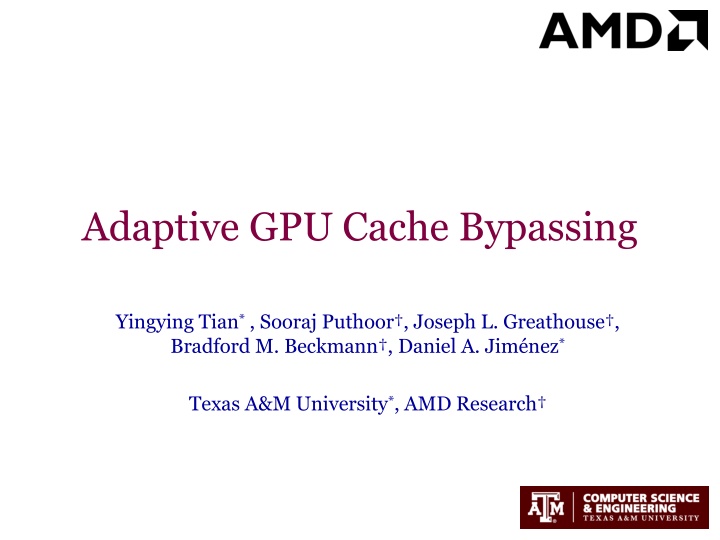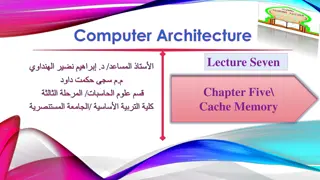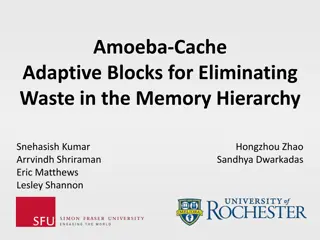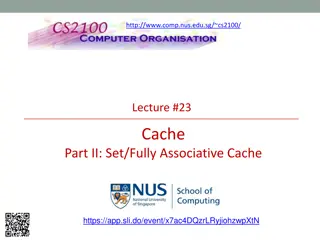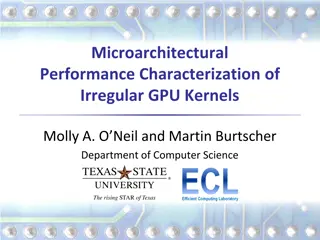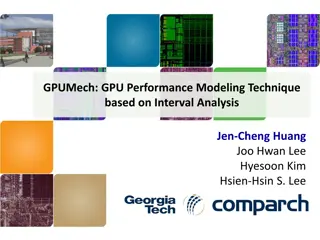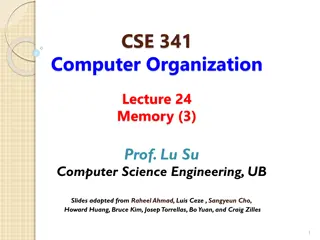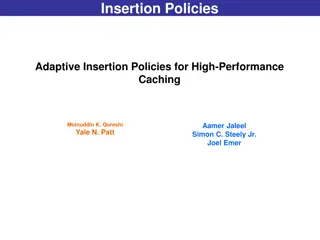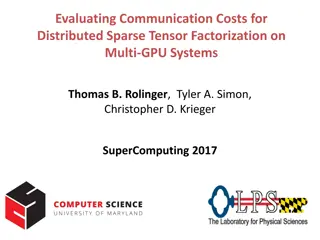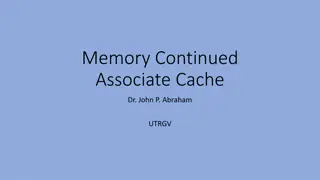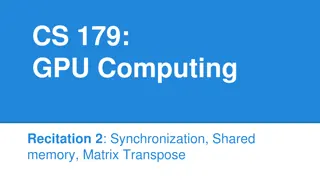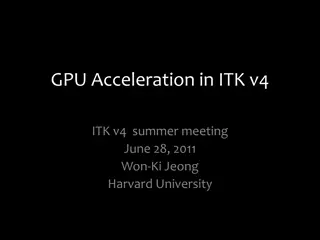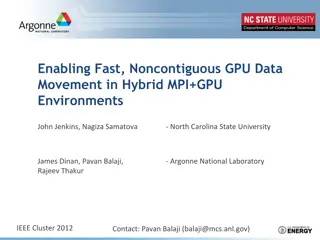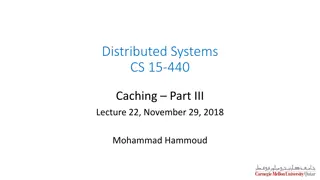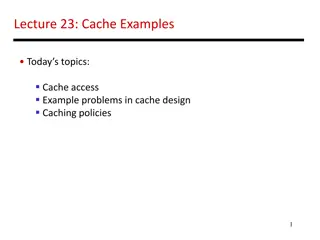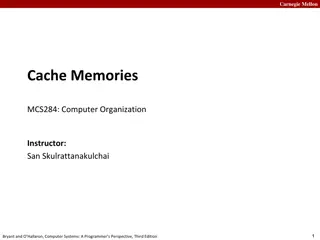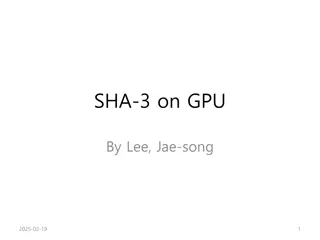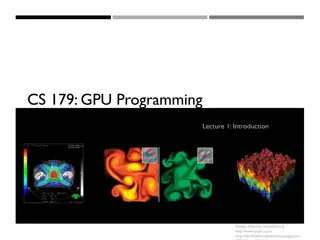Adaptive GPU Cache Bypassing Methodology
This article discusses the inefficiency of GPU caches and introduces an adaptive bypassing methodology to address the issue of inserting zero-reuse blocks. By bypassing these blocks, the performance and energy efficiency of GPU computing can be improved significantly. The methodology involves dynamic bypassing and making predictions based on cache misses using memory addresses and instructions data.
Download Presentation

Please find below an Image/Link to download the presentation.
The content on the website is provided AS IS for your information and personal use only. It may not be sold, licensed, or shared on other websites without obtaining consent from the author.If you encounter any issues during the download, it is possible that the publisher has removed the file from their server.
You are allowed to download the files provided on this website for personal or commercial use, subject to the condition that they are used lawfully. All files are the property of their respective owners.
The content on the website is provided AS IS for your information and personal use only. It may not be sold, licensed, or shared on other websites without obtaining consent from the author.
E N D
Presentation Transcript
Adaptive GPU Cache Bypassing Yingying Tian*, Sooraj Puthoor , Joseph L. Greathouse , Bradford M. Beckmann , Daniel A. Jim nez* Texas A&M University*, AMD Research
Outline Background and Motivation Adaptive GPU Cache bypassing Methodology Evaluation Results Case Study of Programmability Conclusion
Graphics Processing Units (GPUs) Tremendous throughput High performance computing Target for general-purpose GPU computing Programming model: CUDA, OpenCL Hardware support: cache hierarchies AMD GCN: 16KB L1, NVIDIA Fermi: 16KB/48KB configurable
Inefficiency of GPU Caches Thousands of concurrent threads Low per-thread cache capacity Characteristics of GPU workloads Large data structures Useless insertion consumes energy Reducing the performance by replacing useful blocks Scratchpad memories filter temporal locality Less reuse caught in caches Limit programmability
Memory Characteristics Zero-reuse blocks: inserted into caches without being accessed again until evicted 100% Dynamically Accessed Cache Blocks 90% 80% 70% 60% 50% 40% 30% 20% 10% 0% 46% (max. 84%) of L1 cache blocks are only accessed once before eviction Consume energy; pollute cache; cause more replacement
Motivation GPU caches are inefficient Increasing cache sizes is impractical Inserting zero-reuse blocks wastes power without performance gain Inserting zero-reuse blocks causes useful blocks being replaced to reduce performance Objective: Bypass zero-reuse blocks
Outline Background and Motivation Adaptive GPU Cache bypassing Methodology Evaluation Results Case Study of Programmability Conclusion
Bypass Zero-Reuse Blocks Static bypassing on resource limit [Jia et. al 2014] Degrade the performance Dynamic bypassing Adaptively bypass zero-reuse blocks Make prediction on cache misses What information shall we use to make prediction? Memory addresses Memory instructions
Memory Address vs. PC 900000 120 Distinct Cache Blocks Distinct PCs with Load 110 800000 100 700000 90 Instructions Accessed 600000 80 70 500000 60 400000 50 300000 40 30 200000 20 100000 10 0 0 Using memory addresses is impractical due to storage Using memory instructions consumes far less overhead PCs generalize the behaviors of SIMD with high accuracy
Adaptive GPU Cache Bypassing PC-based dynamic Bypass Predictor Inspired by dead block prediction in CPU caches [Lai et. al 2001][Khan et. al 2010] - If a PC leads to the last access to one block, then the same PC will lead to the last access to other blocks On cache misses, predict if it is zero-reuse - If yes, requested block will bypass the cache On cache hits, verify previous prediction and make new prediction
Structure of PC-based Bypass Predictor metadata hashedPC (7-bit) Tag LRU bits Valid bit Cache accesses (PC, addr) Prediction table 4-bit counter Update 128 entries Predict L1 cache HashedPC: the hash value of the PC of the last instruction that accessed this block
Example CU (PC, addr) Miss Prediction table ? Val >= threshold Hash(PC) Get prediction val L1 cache Bypass block
Example (PC, addr) Hit Prediction table val = val -1 HashedPC val Verify prediction L1 cache hashedPC = hash(PC)
Example replacement Prediction table val = val +1 HashedPC val Verify prediction L1 cache
Misprediction Correction Bypass misprediction is irreversible Cause additional penalties to access lower level caches Utilize this procedure to help verify misprediction Each L2 entry contains an extra bit: BypassBit BypassBit == 1 if the requested block will bypass L1 Intuition: if it is a bypass misprediction, this block should be re- referenced soon, and will be hit in the L2 cache Miscellaneous Set dueling Sampling
Outline Background and Motivation Adaptive GPU Cache bypassing Methodology Evaluation Results Case Study of Programmability Conclusion
Methodology In-house APU simulator that extends Gem5 - Similar to AMD Graphics Core Next architecture Benchmarks: Rodinia, AMD APP SDK, OpenDwarfs GPU cache configuration CUs L1 cache Shared L2 cache Shared L3 cache 8, 1GHz, 64 scalar units by 4 SIMDs 8-way, 16KB, 1-cycle tag, 4-cycle data access 16-way, 256KB, 4-cycle tag, 16-cycle data access 16-way, 4MB, 15-cycle tag, 30-cycle data access
Storage Overhead Evaluated Techniques PC-based bypass predictor Prediction table/L1 cache 4-bit * 128 entries Metadata/L1 block 7 bits Metadata/L2 block 1 bit Total cost 224 bytes out of 16KB L1 (1.5%) 0.5KB out of 256KB L2 (0.2%) Counter-based bypass predictor Prediction table/L1 cache 128* 128 entries, 5-bits Metadata/L1 block 20 bits (hashedPC, counters, prediction) Total cost 10.625KB out of 16KB L1 (66.4%)
Outline Background and Motivation Adaptive GPU Cache bypassing Methodology Evaluation Results Case Study of Programmability Conclusion
Energy Savings 100% 100% Percentage of Cache 90% 90% Misses Bypassed 80% 80% L1D Energy Usage vs. 70% 70% 60% 60% 16KB Cache 50% 50% 40% 40% 30% 30% 20% 20% 10% 10% 0% 0% 58% of cache fills are prevented with cache bypassing The energy cost of L1 cache is reduced by up to 49%, on average by 25% Reduces dynamic power by 18% , increases the leakage power by only 2.5%
Performance Improvement 1.14 32KB Cache PC-based Counter-based Performance Normalized to 16KB L1D 1.13 1.12 1.11 1.1 1.09 1.08 1.07 1.06 1.05 1.04 1.03 1.02 1.01 1 0.99 0.98 0.97 0.96 Outperforms counter-based predictor Achieves performance of 32KB upper-bound
Prediction Accuracy False positives: incorrectly bypassed to-be-reused blocks Coverage: the ratio of bypass prediction to all prediction 100% false positives coverage 90% Percent of L1D Accesses 80% 70% 60% 50% 40% 30% 20% 10% 0% Coverage ratio is 58.6%, false positive rate is 12%
Outline Background and Motivation Adaptive GPU Cache bypassing Methodology Evaluation Results Case Study of Programmability Conclusion
Scratchpad Memories vs.Caches Store reused data shared within a compute unit Programmer-managed vs. hardware-controlled Scratchpad memories filter out temporal locality Limited programmability Explicitly remapping from memory address space to the scratchpad address space To what extent can L1 cache bypassing make up for the performance loss caused by removing scratchpad memories?
Case Study: Needleman-Wunsch (nw) nw: Global optimization algorithm Compute-sensitive Very little reuse observed in L1 caches Rewrote nw to remove the use of scratchpad memories: nw-noSPM Not simply replace _local_ functions with _global_ functions Best-effort re-written version
Case Study (cont.) 200 Kernel Execution Time (milliseconds) 180 160 140 120 100 80 60 40 20 0 Nw-noSPM takes 7X longer than nw With bypassing, the gap is reduced by 30% 16KB L1 cache + bypassing outperforms 64KB L1 cache Note that scratchpad memory is 64KB while L1 is only 16KB
Conclusion GPU caches are inefficient We propose a simple but effective GPU cache bypassing technique Improves GPU cache efficiency Reduces energy overhead Requires far less storage overhead Bypassing allows us to move towards more programmable GPUs
Thank you! Questions?
Backup Do all zero-reuse actually streaming? 100% Dynamically Accessed Cache Blocks 90% lifeLongNoReuse zero-reuse 80% 70% 60% 50% 40% 30% 20% 10% 0%
GPU Cache Capacity 1.5 Improvement Normalized 1.4 to 16KB L1 Cache Performance 1.3 1.2 1.1 1 32KB 64KB 128KB 256KB 512KB 1024KB sizes of L1 cache Caches are useful, but current cache size are too small to gain benefit Performance benefit by increasing cache sizes << extra area taken up Adding more computational resources Leading to lower per-thread cache capacity
Power Overhead Energy (nJ) 16KB baseline bypassing per tag access 0.00134096 0.0017867 per data access 0.106434 0.106434 per prediction table access N/A 0.000126232 Dynamic Power (mW) 44.2935 36.1491 Static Power (mW) 7.538627 7.72904
Compare with SDBP SDBP is designed for LLCs, where much of the temporal locality has been filtered our technique is designed for GPU L1 caches, where temporal information is complete. We use PCs because of the observation of characteristics of GPGPU memory accesses. GPU kernels are small and frequently launched, the interleaving changes frequently.
